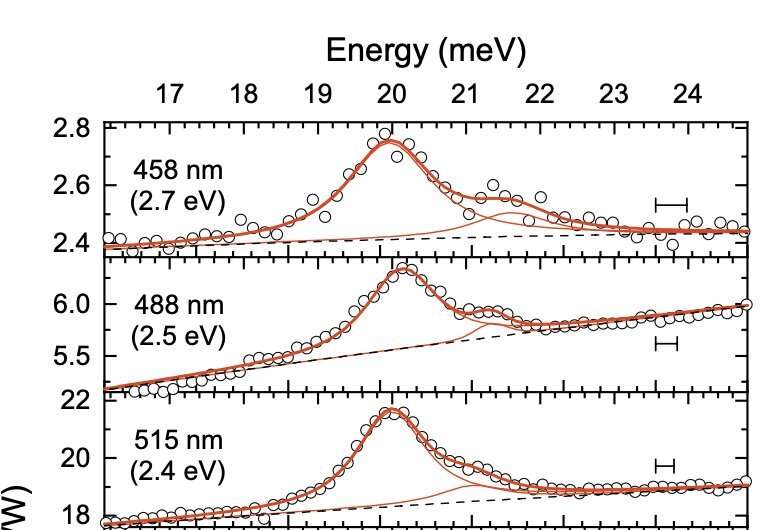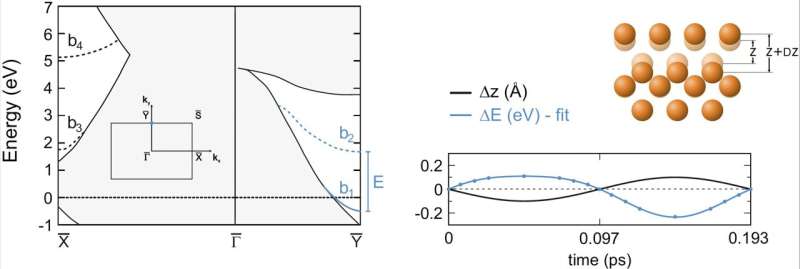June 23, 2022 feature
Study finds evidence of resonant Raman scattering from surface phonons of Cu(110)

Researchers at Johannes Kepler University in Linz have been investigating the physical properties of Cu(110), a surface attained when cutting a single copper crystal in a specific direction, for several years. Their most recent study, featured in Physical Review Letters, provides the first evidence of so-called resonant Raman scattering from the surface of the metal. This phenomenon entails the inelastic scattering of phonons by matter.
"We have already done a lot of research on Cu(110), and are particularly interested in the surface state transition at 2.1 eV. Because the surface state electrons are confined to the first few layers of the crystal, the Cu(110) surface state is a sensitive measure of the condition of the surface. We use this high sensitivity to study various physical processes at the surface, such as reconstruction of the surface after adsorption or molecular growth," Mariella Denk, one of the researchers who carried out the study, told Phys.org.
"In the course of discussions with Prof. Dr. Norbert Esser's group in Berlin, which mainly deals with Raman scattering from semiconductors but also has experience in studying metal surfaces, we came up with the idea of simply trying to see if Raman scattering from surface phonons could be seen on Cu(110)."
In a series of initial experiments, Denk and her colleagues observed a very high intensity Raman scattering from phonons on the surface of a Cu(110) sample. They then decided to explore this surprising observation further to determine the mechanisms underpinning it.
In their experiments, the researchers used a technique called Raman spectroscopy. This is a non-destructive method to conduct chemical analyses, which works by focusing the light from a laser on a sample's surface, covering a spot that is approximately 100 μm in size. The light emitted from this spot is them collected using a lens and enters a monochromator (i.e., an optical instrument that measures the spectrum of light).

"Elastic scattered radiation at the wavelength corresponding to the laser line (Rayleigh scattering) is filtered out, while the rest of the light is dispersed onto a detector," Denk explained. "The laser light interacts with vibrations, phonons, or other excitations in the system, causing the energy of the laser photons to change. The difference in the energies of the incident and scattered light provides information about the excited vibrational modes."
The surface phonons of Cu(110)—as well as their dispersion—were intensively studied by complementary techniques and are well understood. Denk and her colleagues, however, were the first to show that Raman scattering from surface phonons on Cu(110) can be observed and that the high intensity obtained in the experiments is due to scattering in resonance with the electronic transition of the surface state of Cu(110) at a 2.1 eV. They did this by collecting polarization and excitation-energy-dependent Raman measurements on their sample using 10 laser lines, within a photon energy range from 1.8 to 3 eV.
"Our study provides the first evidence for Raman scattering by surface phonons on a metal surface," Denk explained. "The Raman experiments, together with electronic band structure and lattice dynamics calculations, paint a coherent picture of the interaction between surface phonons and surface-localized electronic states."
The findings gathered by this team of researchers could significantly enhance the current understanding of Cu(110) and other metal surfaces. In the future, they could pave the way for further theoretical works focusing on electron-phonon coupling occurring on metal surfaces.
"We are now planning to conduct further experiments to test whether the method can be used for high-resolution surface vibrational spectroscopy, in particular whether optical transitions at surfaces and interfaces can be used to enhance Raman scattering of vibrations of adsorbed species," Denk said.
More information: M. Denk et al, Surface Resonant Raman Scattering from Cu(110), Physical Review Letters (2022). DOI: 10.1103/PhysRevLett.128.216101
Journal information: Physical Review Letters
© 2022 Science X Network





















